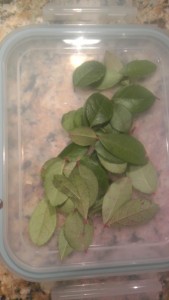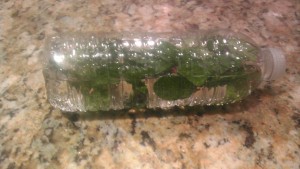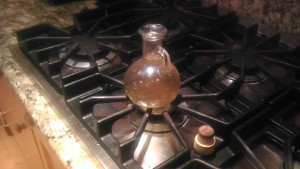This will not be such a learned post, in that I could/should provide a host of links to educative references, so forgive me those who have come to rely on those. Here’s one link though, Wintergreen, that should give gross background, more than that this is a flavor of chewing gum.
The basics here are that it grows in the many oak/pine/maple woods locally and for decades I’ve occasionally picked and bruised a leaf just to smell the very lovely smell, thought of in gum as a kind of mint but really not being a mint at all. Nowadays they get the same flavor from birch twigs so these little leaves get left alone. The plant grows very close the ground, never gets big, but the leaves stay green in the winter. I wonder how it got its name?
I did enough online research to learn that the native Americans made a medicinal tea from it and that just boiling the leaves does a very poor job of extracting either their flavor or their virtue. OK, I did do enough research to learn that the Wampanoag word for it is gôgôwibagok. Say it five times fast. Seems that to extract the flavor and goodness it must be allowed to ferment for some days in a warm place, till it starts to bubble. I washed the leaves, put them in a water bottle, and set them on the windowsill.
Days pass. And more, as if days pass of their own volition. I notice the bubbles. Smells good. Ten days I let it ferment, or at least sit in tepid water. The water vaguely tinted brown. The bubbles never got too rowdy. Eventually I figured I had to boil, test, and bottle.
So far the test has gone well. I drank five ounces 45 minutes ago and here I am typing. The active ingredient is methyl salicylate, a cousin of salicylic acid, which in turn is the active component in aspirin. The easing of aches and pains and the reduction of fever really were the only highlights I could expect, and I did not have aches nor a fever, so I’ll take the absence of detriment as the ok for this concoction. Be warned though, methyl salicylate is toxic in sufficient quantities and you should probably only go this route if your insatiable natural curiosity so commands. To temper the warning though, folk wisdom is wise for a reason. In their day, these leaves helped the sick. You’d have to go way way beyond soaking a handful of leaves in water for a few days, like off the spectrum beyond, to turn a natural medicine into an unnatural disaster.
Anyway these are my happy bits for the day. May you explore the natural world with continuing ontological wonder.



